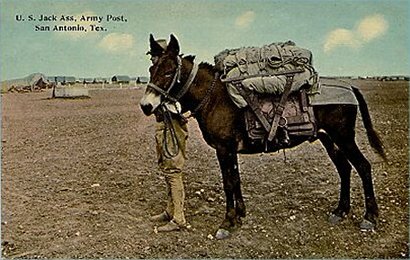|
Although
there were many treasures in early America such as gold and silver,
for a period of years from 1823 to 1850, another treasure generated
huge profits for those involved. The treasure? Mules!
Hard-headed, stubborn, unpredictable, ornery and ugly, the critters
were sorely needed to pull the plows and wagons of the settlers and
carry supplies to the miners and armies.
Originally started by Mexican traders from Mexico when they drove
herds of Jacks, Jennets and mules to Missouri to trade to the power-hungry
settlers needing mule-power for many reasons. The trade grew year
by year with ever-increasing demand.
In 1823, historical records show that four-hundred of the hard-headed
livestock arrived. In 1824 six-hundred came, in 1827 eight-hundred
appeared and in 1832 thirteen-hundred were offered for sale. Missouri
originally was kept as a trading center only. Stock purchased in Mexico
for $7 to $10 a head sold in Missouri for $60 a head. In 1839, prices
broke severely but after the war with Mexico ended the army raised
the prices to $75 per head.
Early on, little mule
breeding was conducted in Missouri. With the importing of stock from
Cuba, Mexico and by Mountain Men bringing herds from the Missions
of California, there was little need for the efforts of local breeding.
Sometime in the late 1830s, the Missouri Mule made its presence
known. Using excellent Jacks from Cuba and Mexico, big work mares
from America, and with huge American studs bred to selected Jennets,
the massive Missouri Mule was created. Larger, taller, more agile
and able to work long hours pulling, living on the same feed and forage
of lesser stock, the improved critter became the preferred work stock
of all the plantations of the South.
All was not lost for the smaller mules.
The smaller Mexican mule, tougher and more secure along mountain
trails was used to ferry mining equipment high among the peaks of
the Rockies. His cousin the pack burro, became a favorite of
the prospectors prowling the dry deserts of the West. |
 |
A mule
in San Antonio U.S.
Army Post
Postcard courtesy www.rootsweb.com/ %7Etxpstcrd/ |
|
Foremost among
those creating demand for mules
were the Army and U.S. Cavalry. Their scattered troops and forts
demanded supplies by the tons and there were few roads anywhere.
The pack mule, branded with the US brand, following a belled
mare, and carrying packs of supplies, came in all sizes and found
steady work all across the new nation.
The mule economy
expanded again as the emigrant wagon trains headed west. The mule,
if he could be afforded, was the power of choice for these trains.
A second economy arose along the way west as heavily-loaded wagons,
lack of experience of owners provided many a worn-out mule to be
traded or abandoned along the trails. Old trappers and scouts seized
the opportunity to trade or find these tired creatures, rest and
feed them back to health and sell or trade for more tired stock.
In spite of the recognized worth of gold and silver, the greater
treasure could have been the lowly mule,
especially if you were stranded on the prairie and needed him to
continue on to your destination.
© Delbert Trew
"It's All Trew" July
7, 2009 Column
Related
Topics:
Mules
Texas Animals
|
|
|
